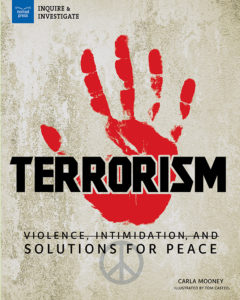Terrorism: Violence, Intimidation, and Solutions for Peace
Author: Carla Mooney
Expected Publication November 15th, 2017 by Nomad Press
Summary: Why did terrorists attack the World Trade Center on September 11, 2001? The answer to that question is ancient, complicated, and crucial to a perceptive understanding of the global community we live in today. In Terrorism: Violence, Intimidation, and Solutions for Peace, readers ages 12 to 15 explore the history, causes, psychology, and potential solutions to the problem of terrorism in an objective way that promotes comprehension and empowerment.
- Investigating previous events in the world’s history can help students understand the causes and effects of current events.
- Activities encourage the development of important skills, including comparing and contrasting, looking for detailed evidence, making deductions, and applying critical analysis to a wide variety of media.
Teacher’s Tools for Navigation and Discussion Questions:
“Teaching Kids Hope” by Carla Mooney
There’s a lot of bad news out there. There’s a lot of good news, too! But unless kids are living in a soundproof room with no cell service or internet access, they’re going to hear at least some of the depressing, no matter how much the adults in their lives try to protect them.
Some of this bad news concerns terrorism. While terrorism has been around since ancient times, the struggle between different ideologies has become far more visible in recent years because of the ease and speed of communication. We all know about attacks happening all around the world, almost as soon as they happen. Kids included.
When the bombing at the Ariana Grande concert in Manchester, England, happened last spring, the audience was full of young teens, fans of the singer, and it was teenagers who were watching events unfold via texts and posts from other kids around the world. Just about every elementary school has a ceremony of some kind on September 11—children who weren’t even alive when the Twin Towers fell spend time recognizing the victims and honoring their memories.
Terrorism is all around us, even when we live in what we consider safe societies that have not yet been touched directly.
How do we—as educators, parents, and mentors—support children as they grow up in a world where terrorism is a regular occurrence? How do we teach them to think critically and creatively about potential solutions? How do we create that balance between knowing the issues and not letting that knowledge cause fear and anxiety, when the reality is the vast majority of citizens will not experience a terrorist attack in their lifetime? How do we get kids to see themselves as part of the solution and empower them to make wise choices, learn about the issues, and work to find solutions?
This might sound like a tall order for kids, but maybe they are the generation that will solve the problems of terrorism.
I wrote my book Terrorism: Violence, Intimidation, and Solutions for Peace specifically with the intent of providing kids with not just the history of terrorism (which is an important part of recognizing its role in today’s world), but also as a jumping off point to start thinking about how to curb terrorism.
Here are three activities I came up with to help kids understand that while terrorism is a very real part of life, it’s not a problem that can’t be solved. I hope you find them useful, and remember, never give up hope.
ASSASSINATIONS—AN ACT OF TERROR?
Throughout history, assassination is one tactic used by terror groups to achieve certain goals. However, not every assassination is an act of terror. When should murders of political figures be considered acts of terror or when are they simply horrible crimes? What separates terrorism from criminal activity?
- Choose a political leader who was assassinated or who survived an assassination attempt. Some leaders to consider researching include:
- Abraham Lincoln
- William McKinley
- Czar Alexander II of Russia
- Indira Gandhi
- Benazir Bhutto
- Research the assassination attempt on your chosen Consider the following questions.
- Who was the leader? Where were they from? What country did they lead?
- What political or social views did the leader have that were controversial?
- Who was the perpetrator?
- What was the perpetrator’s objective? Did they succeed?
- Did their actions affect history in the short-term? In the long-term?
- Was the assassination attempt an act of terror? Explain your point of view.
THE PROCESS OF RADICALIZATION
The process of radicalization is different for every individual. While the path each person takes toward adopting extremist views is different, are there some similarities? By studying the radicalization of several different individuals, you can look for common themes in their stories.
- The stories of radicalization for several people can be found online. You can read and listen them here.
- Alex, a 23-year-old Sunday school teacher and babysitter
- Dzhokhar Tsarnaev, one of the Boston Marathon bombers
- Mohammed Hamzah Khan, a Chicago teenager
- After reading each of their stories, consider what factors made each person susceptible to becoming radicalized.
- What similarities did you find in their paths to radicalization?
- What differences?
- What outcomes did each individual have?
- What made their outcomes different?
PREVENTING TERROR ATTACKS
While successful terror attacks make headlines around the world, there are dozens of plots that have been thwarted by counterterrorism efforts. You can read about some of these plots here.
- Select three or four thwarted terror plots to research. Find and read newspaper or magazine articles about the foiled attacks.
- Create a chart to categorize the plots.
- What types of attacks were planned?
- What methods did terrorists use?
- Who was involved?
- What targets did they choose?
- What was the objective?
- How was the plot stopped?
- What counterterrorism methods were used?
- What was the outcome?
- Does the number of thwarted terror plots make you feel more or less secure? Explain.
About the Author: Carla Mooney is the author of many books for young readers including Globalization: Why We Care About Faraway Events, The Holocaust: Racism and Genocide in World War II, Forensics: Uncover the Science and Technology of Crime Scene Investigation, The Industrial Revolution: Investigate How Science and Technology Changed the World and Explore Rivers and Ponds! With 25 Projects from Nomad Press. Her work has appeared in many magazines including Highlights, Faces, and Learning Through History. Carla lives in Pittsburgh, Pennsylvania.
Thank you to Carla for her important post with so many useful tools and to Andi from Nomad Press for introducing us to this book!



